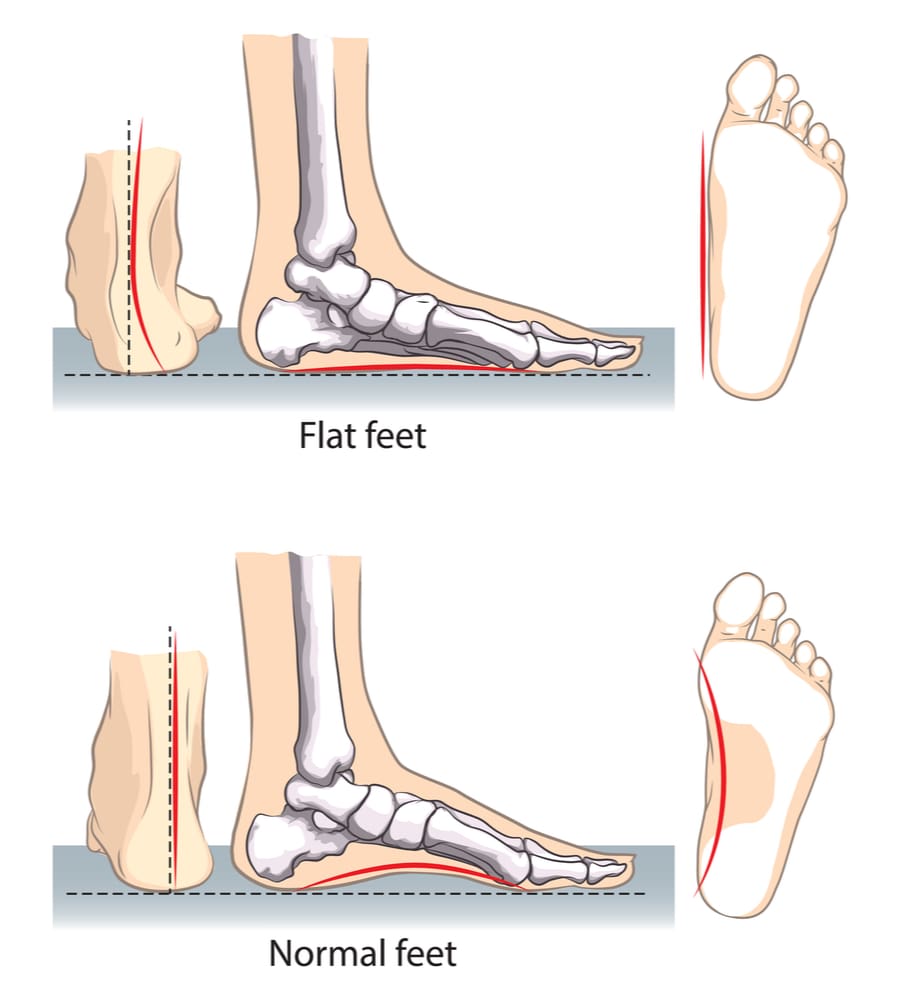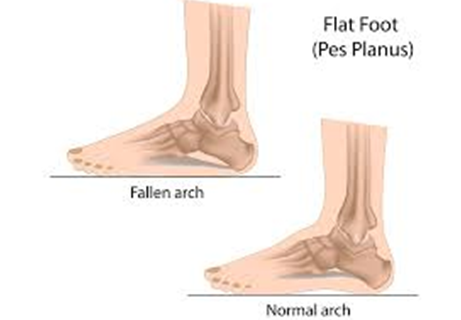Written by Dr Gowreeson Thevendran, MBChB (Bristol), MRCS.Ed, Dip. Sports Med.Ed, FRCS.Ed (Trauma & Ortho. ), FAMS (Singapore)
What is Flat Feet?
If you have flat feet, this means that the arch of your foot is lower than normal and the entire sole can touch the floor when standing. Yet, it is important to know that this is a condition that may not affect your quality of life and not every person with flat feet requires surgical treatment in Singapore. However, if you experience swelling or pain in the foot and ankle among other symptoms, flat foot reconstruction surgery is an option when you are starting to find it difficult to walk.
Causes of Flat Feet
Also known as pes planus, flat feet can be either an inherited condition or a result of physical injury or illnesses such as diabetes and rheumatoid arthritis. This can cause problems in both children and adults. A flat foot can lead to pain in other parts of the body as well as cause abnormal wear on your shoes or foot deformities like bunions.
In the case of bunions, your doctor may also suggest minimally invasive bunion surgery, depending on the severity of the bump.
Symptoms of Flat Feet
The arches of your foot are made up of three different ligaments, one from each side and one from the middle. These ligaments should support the weight of your foot and keep them aligned properly so that it does not hurt to walk or stand for long periods. However, when the foot arch does not rise high enough, and the entire sole touches the floor when weight is put on the foot, this could be an indication of flat feet.
When one has flat feet, this can create other issues, such as:
- Plantar fasciitis (chronic sharp pain in the heel of your foot)
- Leg cramps
- Muscle pain in the arch, ankle or outside of the foot
- Toe drift (when the front part of the foot and toes point outward)
The Types of Flat Feet
If you are experiencing symptoms of flat feet, it is also important to note that there are different types of flat feet:
- Flexible: This is the most common type where the arch is visible on both feet when one is not standing.
- Rigid: This type shows no arches, regardless of whether you are sitting or standing. It can also affect just one or both feet, making it difficult for people to walk comfortably.
- Adult-acquired: This type of flat foot is commonly caused by an inflammation or tear in the leg tendon.
- Vertical talus: This is the result of a birth defect that prevents the natural arches from forming.
Diagnosing Flat Feet
A flat foot is diagnosed through a physical exam, where the orthopaedic specialist assesses the foot and ankle for any visible signs of a flat foot, such as a low arch or a foot that appears to roll inward when walking. The doctor may also perform tests to evaluate the strength and flexibility of the foot and ankle, as well as the range of motion in the foot and ankle joints, to prescribe the right therapy plan.
In some cases, X-rays may be ordered to obtain images of the bones and joints in the foot and ankle. This can help identify any abnormalities in the bones or joints, as well as any arthritis or other conditions that may be contributing to the flat foot. In rare cases, additional tests may be ordered to rule out other conditions that may be causing the flat foot, such as nerve or muscle disorders.
Non-surgical Treatment for Flat Feet
Most flat feet can be managed with non-surgical methods such as shoe inserts, braces and physical therapy. However, if these non-invasive methods are unsuccessful, you may consider surgical intervention through flat foot reconstruction to adequately relieve painful symptoms.
What Happens During Flat Foot Surgery
Depending on the individual, different types of surgery may be performed to treat the flat foot as reconstruction can be done to create an arch, repair tendons, or lengthen the Achilles tendon. Minimally invasive surgeries may also be done to create a natural space between the ankle and the heel bone.
In general, flat foot reconstruction is done under general anaesthetic to numb the foot and reduce the pain post-operation. Depending on the surgery, the surgeon might shift the heel bone back to the correct alignment under the leg, remove the damaged tibial tendon or replace it. They can also repair or reconstruct the damaged spring and deltoid ligament or make incisions and spread the bone apart to recreate an arch.
Recovery Period For Flat Foot Surgery
After the surgery, soreness or discomfort is commonly experienced, but it is easily managed with rest and over-the-counter pain medication. Swelling or bruising may also occur, but this is typically temporary and will subside within a few days.
In certain cases, patients may experience an allergic reaction to medications or anaesthesia used during the treatment, and infection is also a potential risk, although it is rare. If you have any concerns about potential implications, you should discuss them with your doctor before undergoing any flat foot treatment.
Once the initial discomfort from the surgery subsides, it usually takes up to four months before you may transition to wearing shoes. Additionally, a full recovery may take up to two years. During this time, it is important that you will need to follow specific rehabilitation instructions such as going for physical therapy to help ensure a successful outcome.

Dr Gowreeson Thevendran
MBChB (Bristol), MRCS.Ed, Dip. Sports Med.Ed, FRCS.Ed ( Trauma & Ortho. ), FAMS (Singapore)
Dr Gowreeson Thevendran is an orthopaedic surgeon who specialises in lower limb orthopaedic conditions, trauma, and fracture surgeries of both the upper and lower limbs. He received his medical education from the University of Bristol and completed his surgical training in the UK and Canada. Before establishing his private practice, he served as Chief of Foot & Ankle Surgery, Department of Orthopaedics at Tan Tock Seng Hospital, Singapore.
Dr Gowreeson Thevendran’s Qualifications and Awards:
- Bachelor of Medicine and Surgery, University of Bristol, England
- Fellow of the Royal College of Surgeons, Edinburgh
- Diplomate Faculty of Sports and Exercise Medicine, Royal College of Surgeons Edinburgh
- Fellow of the Academy of Medicine, Singapore
- SICOT PIONEER Founders Award 2020
- 2015 European Foot & Ankle Society ‘Best Podium Presentation’ Award
- 2013 Singapore Orthopaedic Association Junior Travelling Fellowship
- 2012 NHG Critical Talent Special Recognition Award
- 1998 Enid Lindt Prize in Clinical Surgery
- 1995 Public Services Department Full Medical Scholarship
Frequently Asked Questions about Flat Foot Surgery
Pronation is the natural motion of your foot that occurs when you walk or run. Yet, when the arch on the inside of your foot flattens out, it can cause overpronation. In this case, the heel bone rotates inward and can cause excessive movement in the ankle joint and instability in the knee joint. Flat feet are a major risk factor for overpronation as they lack arches.
People who overpronate are also more likely to have:
- Calluses
- Pain in the foot arch, knee, hip and/or back
- Hammer toes
Yes, flat feet are also sometimes referred to as fallen arches. Flat feet are characterised by an abnormally flattened arch that falls toward the ground from a young. Fallen arches may be used to describe a flat feet condition – caused by the collapse of the arch on one or both feet – that has developed over time as one ages. When the pain becomes severe, you may wish to consult your orthopaedic doctor for flat foot treatment options, which may include flat foot reconstruction surgery.
Clinic Location
OrthofootMD@Novena
- Mount Elizabeth Novena
38 Irrawaddy Road #05-42 Mount Elizabeth Novena Specialist Centre Singapore 329563
OrthofootMD@Mount Alvernia Hospital
- (Mount Alvernia Hospital)
820 Thomson Road #01-01/02 Mount Alvernia Medical Centre A Singapore 574623
Dr Gowreeson Thevendran is currently an orthopaedic surgeon with Island Orthopaedic, a one-stop care centre for orthopaedic health under Healthway Medical Group. He specialises in treating lower limb orthopaedic conditions, as well as trauma and fracture surgery of both the upper and lower limbs. Prior to establishing his private practice, Dr Gowreeson was Chief of Foot & Ankle Surgery at the Department of Orthopaedics at Tan Tock Seng Hospital (TTSH). Today, he continues to serve the Orthopaedic Department at TTSH as a visiting consultant.

